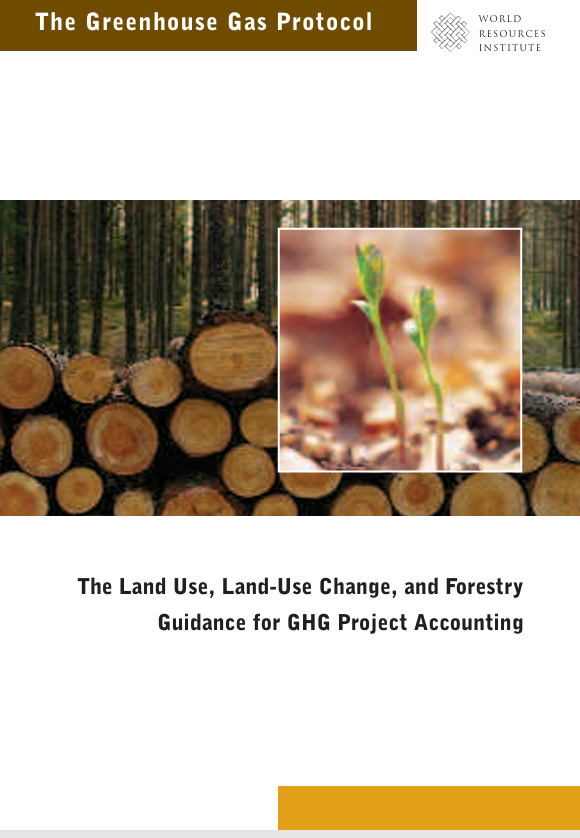
The greenhouse gas protocol: Land use, land-use change, and forestry (LULUCF) guidance for GHG project accounting
The land use, land-use change, and forestry (LULUCF) guidance for GHG project accounting provides structured methods to quantify and report greenhouse gas (GHG) reductions from reforestation and forest management projects. It supplements the GHG Protocol for Project Accounting, detailing baseline procedures, monitoring, and risk mitigation approaches specific to land-based carbon projects.
Please login or join for free to read more.

OVERVIEW
Chapter 1: Introduction
The land use, land-use change, and forestry (LULUCF) guidance supplements the Greenhouse Gas (GHG) Protocol for Project Accounting, offering tailored methods to quantify and report GHG reductions from reforestation and forest management projects. Developed by the World Resources Institute (WRI), the guidance complements the Project Protocol. It targets project developers, third-party verifiers, and programme administrators calculating GHG reductions or removals from land-based projects. The focus is on reforestation and forest management, with limited reference to avoided deforestation.
Chapter 2: Key LULUCF accounting concepts and principles
Key concepts include carbon stocks, GHG removals, baseline candidates, trend factors, variability, uncertainty, permanence, and additionality. GHG removals are calculated by changes in carbon stocks over time, converted using a factor of 44/12 (CO₂/C). Both biological and non-biological effects are included. Baselines are derived using either project-specific or performance standard procedures. A trend factor may be applied to reflect changing practices. Variability and uncertainty must be documented. Additionality is determined through deviations from the baseline.
Chapter 3: efining the GHG assessment boundary
This chapter details identifying project activities and associated effects. Secondary effects include emissions from fertiliser use, site preparation, and market responses. These are categorised into one-time, upstream, and downstream effects. Significant secondary effects should be included unless shown to be negligible. Recommended actions include using emission factors or models and applying conservative assumptions.
Chapter 4: Selecting a baseline procedure
Two procedures are proposed: project-specific and performance standard. The choice depends on the availability of verifiable data, number of similar projects in the area, and data on land-use practices. Project-specific baselines involve qualitative barrier assessments, while performance standards require quantitative rankings of GHG removals.
Chapter 5: Identifying the baseline candidates
Baseline candidates are feasible land uses or management practices. Geographic and temporal boundaries must reflect the project site. Legal, biophysical, and infrastructural factors help narrow options. Candidates should also reflect common practice within the defined region and time.
Chapter 6: Estimating the baseline GHG removals—project-specific procedure
Select a baseline scenario based on barriers and, if needed, net benefit comparisons. GHG removals are calculated from changes in carbon stocks. Ex-ante and ex-post estimations are permitted. Land-use trend factors should be used where relevant.
Chapter 7: Estimating the baseline GHG removals—performance standard procedure
Use time-based metrics to calculate GHG removals across land units. Various stringency levels (mean, median, percentiles) help define baselines. The standard should reflect better-than-average practices and may incorporate land-use trends.
Chapter 8: Applying a land-use or management trend factor
This factor adjusts baseline removals to reflect changing land-use patterns. It is used when historical data exist and activities represent discrete land-use changes. Methods include statistical analysis and modelling.
Chapter 9: Estimating and quantifying carbon stocks
Relevant carbon pools include living biomass, dead organic matter, and soils. Methods include sampling, default values, and models. Uncertainty must be addressed conservatively. Ex-post quantification should be based on verified measurements.
Chapter 10: Monitoring and quantifying GHG reductions
Monitoring plans must detail how effects are tracked and include QA/QC. GHG reductions are the difference between project and baseline removals. Material secondary effects and reversals must be included.
Chapter 11: Carbon reversibility management plan
Carbon may be re-emitted due to planned or unplanned events. The plan must identify risks, mitigation strategies (e.g., easements, fire control), and compensation measures (e.g., insurance, buffer pools). Monitoring indicators must track risks over time.
Chapter 12: Reporting GHG reductions and total carbon stocks
Reporting must be transparent and include assumptions, data, and methods. Developers should describe baselines, GHG reductions, monitoring, and risk management. Annual reports are encouraged, with third-party verification if required.


